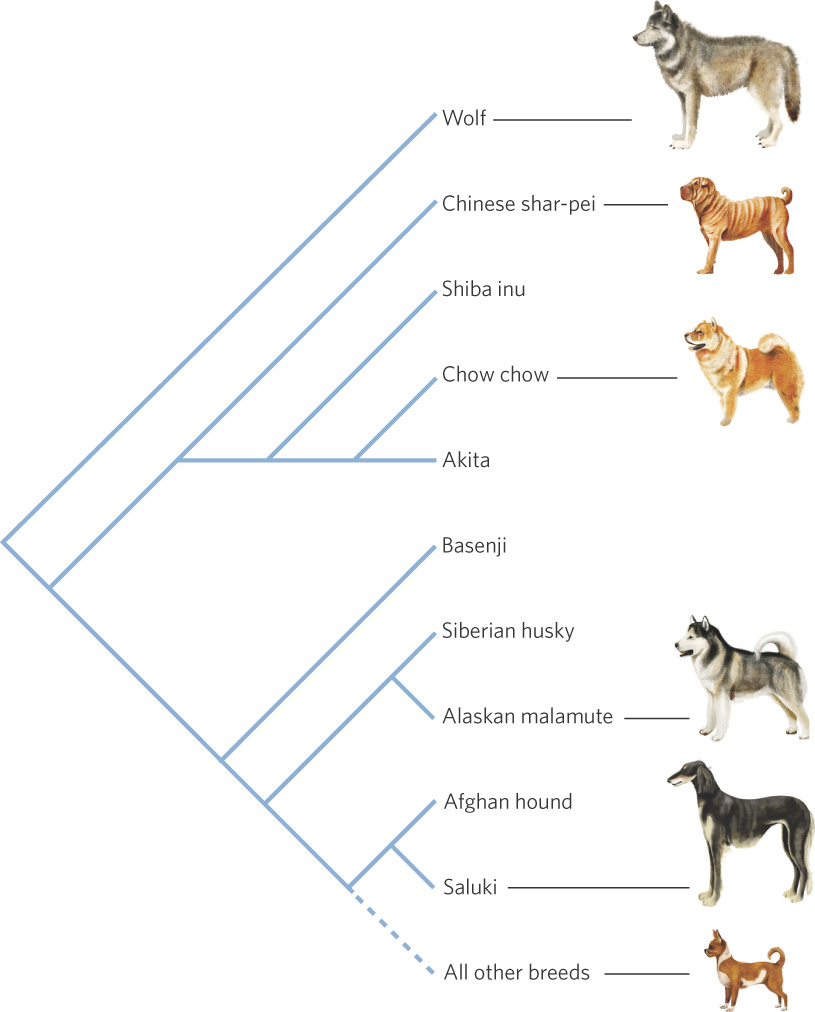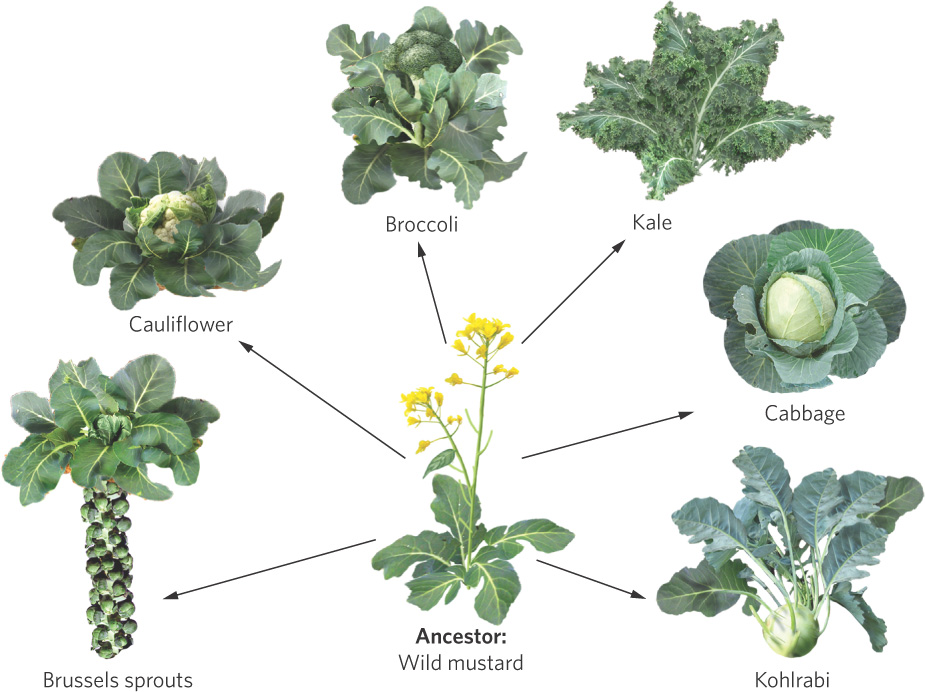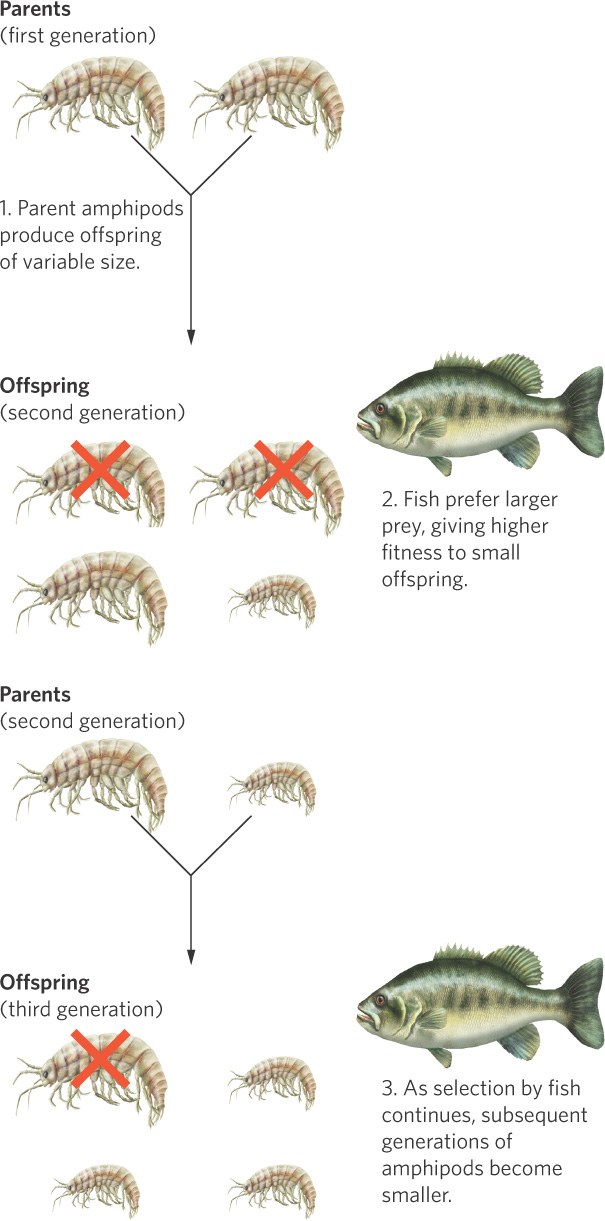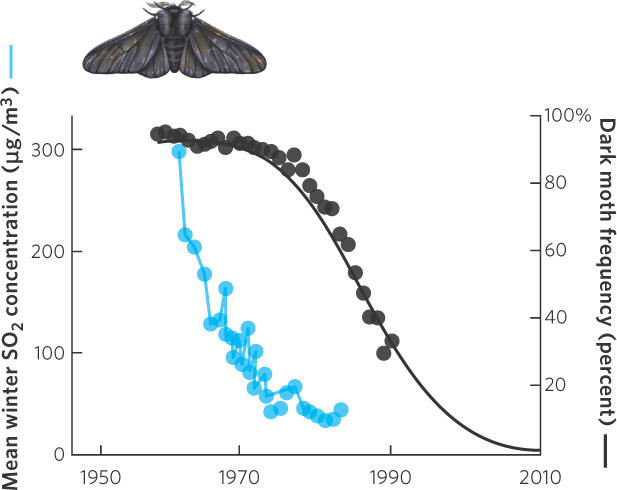Microevolution operates at the population level
Microevolution The evolution of populations.
The random and nonrandom processes that cause evolution can operate at a variety of levels. The evolution of populations is known as microevolution, and it is pervasive. It is the process responsible for producing different breeds of cats, cattle, and dogs, and for producing distinct populations of wild organisms including salmon, bears, and the flu virus. Microevolution is affected by both random process and selection. Selection at the microevolution level can be further divided into artificial selection and natural selection.
Artificial Selection
In his book On the Origin of Species, Charles Darwin discussed the wide variety of domesticated animals that humans have bred to produce particular suites of traits. In the case of dogs, for example, humans began by domesticating gray wolves. Over time they bred individuals that possessed particular characteristics, such as body size, coat color, and hunting ability. As shown in Figure 7.12, just a few centuries of breeding have created dog breeds with widely divergent phenotypes—from Saint Bernards to Chihuahuas.

174
Artificial selection Selection in which humans decide which individuals will breed and the breeding is done with a preconceived goal for the traits of the population.
All of these dogs belong to the same species as the wolf and could potentially interbreed. This is an example of artificial selection, in which humans decide which individuals will breed and the breeding is done with a preconceived goal for the traits desired in the population. Similar artificial selection has occurred to create numerous breeds of other domesticated animals, including cattle, sheep, pigs, and chickens.
Artificial selection also has been applied to plants. One of the best-known examples is the breeding of wild mustard (Brassica oleracea). As you can see in Figure 7.13, the wild mustard has been bred into a diversity of vegetables by selecting for unique stem, leaf, and flower traits. Today, the wild mustard can be consumed as cabbage, brussels sprouts, cauliflower, broccoli, kale, and kohlrabi.

Human practices may unintentionally lead to artificial selection, sometimes with detrimental consequences. For example, the widespread application of pesticides has caused resistance in more than 500 species of pests that harm food production and human health. Similarly, extensive use of antibiotics has caused many harmful human pathogens to evolve resistance to antibiotics, as described in “Drug-Resistant Tuberculosis” at the end of this chapter. In these cases, the role of evolutionary mechanisms is clear. When pesticides or antibiotics are targeted at millions of organisms, a small number of individuals commonly carry a mutation that confers resistance. Since only the mutants survive and the mutation is heritable, the next generation becomes more resistant.
Darwin’s case for evolution by natural selection was strengthened by his observations of how artificial selection worked. He argued that if humans could produce such a wide variety of animal and plant breeds in a few centuries through artificial selection, natural selection could certainly have had similar effects over millions of years.
Natural Selection
A person conducting artificial selection typically has a particular suite of traits in mind, for example, increased milk production in cattle. This is not the case for natural selection, which favors any trait combination that provides higher fitness to an individual. Artificial and natural selection both operate by favoring certain traits over others. Both select on traits that are heritable; the difference is in how traits are selected. There can be multiple ways to improve an individual’s fitness, and all of them are favored by natural selection, regardless of the resulting phenotype. For example, a prey organism might reduce its probability of being eaten either by hiding from predators so it is not detected or by growing spines so that it cannot be eaten. Both strategies are effective at improving the prey’s fitness and both traits could be favored by natural selection. In artificial selection, humans determine the fitness of traits and they often select attributes for particular purposes that would actually reduce the fitness of individuals if they lived in the natural environment.
175
Most evolutionary biologists agree that the diversification of organisms over the long history of life on Earth has occurred primarily by natural selection. Natural selection is an ecological process: It occurs because of differences in reproductive success among individuals endowed with different form or function in a particular environment. That is, as individuals interact with their environment—including physical conditions, food resources, predators, other individuals of the same species, and so on—traits that lead to greater fitness in that environment are passed on.
Evolution by natural selection is a common phenomenon in populations. For example, many predators cause selection on the traits of their prey. We can see this process in Figure 7.14 for fish that prey upon amphipods, a tiny crustacean species. The parent amphipods produce an abundance of offspring that vary in size. However, fish prefer to consume the largest amphipods because they offer the highest amount of energy per unit effort. Smaller amphipods are more likely to survive, and since body size is a heritable trait in amphipods, subsequent generations evolve smaller body sizes.

One of the most striking demonstrations of microevolution is the case of the peppered moth (Biston betularia). During the early nineteenth century in England, most individuals of this moth were white with black spots, but occasionally there would be a dark, or melanistic, individual (Figure 7.15a). Over the next hundred years, dark individuals became more common in forests near heavily industrialized regions, a phenomenon often referred to as industrial melanism. In regions that were not industrialized, the light phenotype still prevailed.

Industrial melanism A phenomenon in which industrial activities cause habitats to become darker due to pollution and, as a result, individuals possessing darker phenotypes are favored by selection.
Since melanism is an inherited trait, it seemed reasonable to suppose that the environment must have been altered to give dark forms a survival advantage over light forms. The specific agent of selection was easily identified. Peppered moths rest on trees during the day. Scientists observed that air pollution in industrial areas had darkened the trees with soot, as shown in Figure 7.15b, so they suspected that the predatory birds could see the lighter moths more easily. Because trees in nonpolluted regions were much lighter in color, the dark moths in these regions would be more visible. To test these hypotheses, equal numbers of light and dark moths were placed on tree trunks in polluted and unpolluted woods. As you can see in Figure 7.15c, when both types of moths were attached to the light-colored trees in unpolluted regions, birds consumed more dark moths. When both types of moths were attached to the dark-colored trees in polluted regions, birds consumed more light moths. This confirmed that the change in phenotypes observed over time in England reflected evolution of the population in response to changing environmental conditions.
In recent years, as pollution control programs reduced the amount of soot in the air and improved the conditions of the forests, the frequencies of melanistic moths have decreased, as we would expect. Figure 7.16 shows data for the area around the industrial center of Kirby in northwestern England. As the amount of pollution declined—measured in terms of sulfur dioxide and shown as a blue line—the bark of the trees began to turn lighter. After two decades of decreasing pollution, the trees became lighter and the frequency of the dark form of the moth decreased from more than 90 percent of the population in 1970 to about 30 percent by 1990, as shown by the black line. Similar to the medium ground finches discussed at the beginning of this chapter, the story of the melanistic moths demonstrates that microevolution can occur in a relatively short time.

176